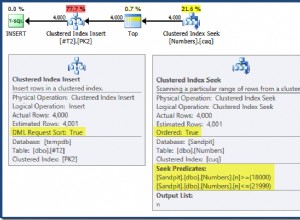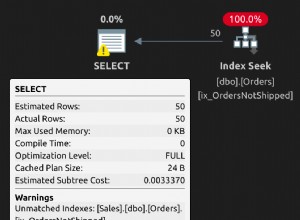Se você tivesse um número conhecido de valores para
order e item , então você pode codificar a consulta em:select id,
max(case when `order` = 1 then data end) order1,
max(case when `order` = 2 then data end) order2,
max(case when `order` = 3 then data end) order3,
max(case when item = 1 then price end) item1,
max(case when item = 2 then price end) item2,
max(case when item = 3 then price end) item3,
max(case when item = 4 then price end) item4
from tableA
group by id;
Veja Demonstração . Mas parte do problema que você terá é porque você está tentando transformar várias colunas de dados. Minha sugestão para obter o resultado final seria desarticular os dados primeiro. O MySQL não possui uma função unpivot, mas você pode usar uma UNION ALL para converter os vários pares de colunas em linhas. O código para unpivot será semelhante ao seguinte:
select id, concat('order', `order`) col, data value
from tableA
union all
select id, concat('item', item) col, price value
from tableA;
Veja Demonstração . O resultado disso será:
| ID | COL | VALUE |
-----------------------
| 1 | order1 | P |
| 1 | order1 | P |
| 1 | order1 | P |
| 1 | item1 | 50 |
| 1 | item2 | 60 |
| 1 | item3 | 70 |
Como você pode ver, isso levou as várias colunas de
order /data e item /price e convertê-lo em várias linhas. Quando isso for concluído, você poderá converter os valores novamente em colunas usando uma função agregada com um CASE:select id,
max(case when col = 'order1' then value end) order1,
max(case when col = 'order2' then value end) order2,
max(case when col = 'order3' then value end) order3,
max(case when col = 'item1' then value end) item1,
max(case when col = 'item2' then value end) item2,
max(case when col = 'item3' then value end) item3
from
(
select id, concat('order', `order`) col, data value
from tableA
union all
select id, concat('item', item) col, price value
from tableA
) d
group by id;
Veja Demonstração . Finalmente, você precisa converter o código acima em uma consulta de instrução preparada dinâmica:
SET @sql = NULL;
SELECT
GROUP_CONCAT(DISTINCT
CONCAT(
'max(case when col = ''',
col,
''' then value end) as `',
col, '`')
) INTO @sql
FROM
(
select concat('order', `order`) col
from tableA
union all
select concat('item', `item`) col
from tableA
)d;
SET @sql = CONCAT('SELECT id, ', @sql, '
from
(
select id, concat(''order'', `order`) col, data value
from tableA
union all
select id, concat(''item'', item) col, price value
from tableA
) d
group by id');
PREPARE stmt FROM @sql;
EXECUTE stmt;
DEALLOCATE PREPARE stmt;
Consulte SQL Fiddle com demonstração . Isso dá um resultado:
| ID | ORDER1 | ORDER2 | ORDER3 | ITEM1 | ITEM2 | ITEM3 | ITEM4 |
-------------------------------------------------------------------
| 1 | P | Q | (null) | 50 | 60 | 70 | (null) |
| 2 | P | (null) | S | 50 | 60 | (null) | 80 |




